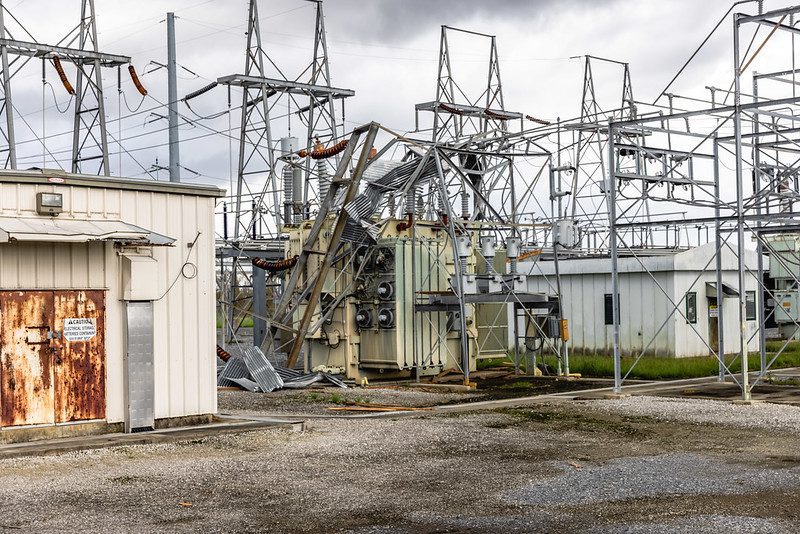Entergy: Hurricane Ida Took Out Eight Critical High-Voltage Transmission Lines
Moving quickly after devastating winds from Hurricane Ida on Aug. 29 took out eight critical high-voltage lines and blacked out New Orleans, Jefferson, and two other Louisiana parishes, Entergy hashed out two options. One—the “preferred solution”—was to restore some of the critical transmission lines that tie Greater New Orleans to the larger MISO grid, and the second was to create an “island” that would temporarily isolate the Greater New Orleans region from MISO.
Entergy ultimately went with a pairing of the two. As restoration crews set out to repair transmission structures, Entergy established a temporary “standalone grid” powered mainly by the 128-MW New Orleans Power Station in Eastern New Orleans and Ninemile 6 in Westwego. As the company noted, the May 2020-commissioned New Orleans Power Station—a reciprocating engine plant—was designed to assist with storm restoration, given its self-start capability and ability to ramp-up to full capacity in a few minutes. Ninemile 6, Entergy’s 2015-completed two-unit 560-MW combined cycle plant just outside New Orleans, was also designed for resiliency. The plant has a dual-fuel (gas and fuel oil) capability, an essential consideration given its location, which was hit hard by Hurricane Katrina in 2005.
The decision came after a grueling two days during which a crew of 18,350 storm workers (from 38 states) assessed the vast damage and destruction across the region. Hurricane Ida’s Category 4 winds, 15-foot storm surge, and widespread flooding made it an especially devastating storm to hit the Entergy region. “The estimated 950,000 customers affected is second only to Hurricane Katrina’s 1.1 million who were left without power,” the company noted. At around 6:30 p.m. Central Time on Aug. 31, citing the reporting efforts of mutual storm crews, Entergy reported that 216 substations, 208 transmission lines were affected, along with 2,438 poles, 550 transformers, 2,984 spans of wire on the distribution system were damaged or destroyed in Louisiana and Mississippi.

And at 1:22 a.m. on Sept. 1, the “first light” shone in New Orleans East. “The first light is a sign of hope, early this morning, as Entergy crews turn power on for some customers in eastern New Orleans with generation supplied by the New Orleans Power Station,” the company reported. Efforts then turned to powering critical infrastructure, including hospitals, nursing homes, and first responders in Orleans, Jefferson, St. Bernard, and Plaquemines parishes, as well as parts of St. Charles and Terrebonne parishes. By 10 a.m., though Entergy reported more fluid progress on the distribution system, it said more than 1,600 miles of transmission lines still remained out of service, and it warned that the hardest-hit regions could experience power outages for weeks.
Evening two after #HurricaneIda 1.03 million electric customers remain without power.
Utilities work on rebuilding the transmission systems, which are needed before any progress can be made in restoring power to SE LA region.https://t.co/SWmJJoW5GD
[2021-08-31 8:12 PM CDT] pic.twitter.com/ympO1JYcSt— PowerOutage.us (@PowerOutage_us) September 1, 2021
“As roads clear and we gain access to new parts of our territory, we continue discovering heavy damage to our facilities. Gaining access will allow us to get resources into those areas to assess damage and restore service where it is safe to do so,” it said. In Louisiana, the company said it was prioritizing completing damage assessment “as quickly as possible” to provide for the logistics needs of its workers and “aligning our distribution and transmission recovery to provide electricity to as many customers as quickly as possible.” In Mississippi, where damage assessment was nearly complete, Entergy determined the hardest-hit areas were the Brookhaven/McComb and Natchez/Gloster areas.
By 5 p.m. on Sept. 1, workers had steadily created a restored “loop” toward Ninemile on the West Bank, “from west to southeast then back around,” the company said. Around 68 of 220 affected substations and 44 of 210 affected transmission lines had returned to service. Adding some complexity to transmission repair is southeast Louisiana’s unique landscape, the company acknowledged. “Entergy’s transmission system spans land, water, and marsh. In many cases, special equipment will be used as we inspect, repair, and replace the steel, concrete and tensioned wires that are the foundation for our structures,” it said.
Despite these challenges, as of 9 a.m. on Sept. 2, the company reported its team had been able to assess about 58% of the impacted infrastructure in Louisiana. “Assessments will continue over the next few days, but that may be extended for the more extensively damaged areas in the state.”
The next days and weeks “will be difficult for our region,” the company said. “But our workforce is here to lead the recovery, working until the last light is turned on.”
—Sonal Patel is a POWER senior associate editor (@sonalcpatel, @POWERmagazine).